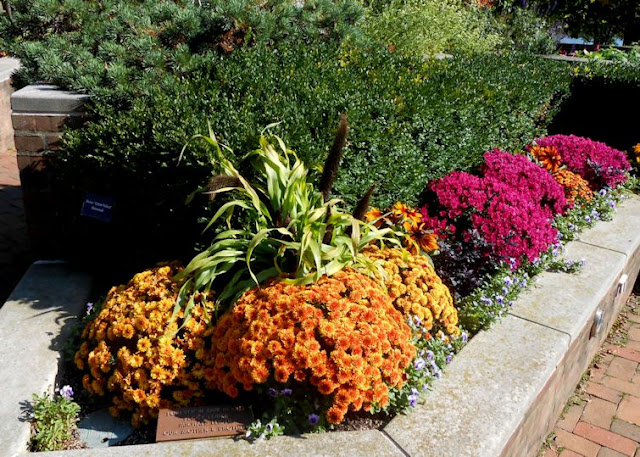The "Enabling Garden" has all elevated growing beds and shows how you can garden
successfully even if you can't kneel down or bend over. Here is the entrance with
"Pink Pop-Eye" Chrysanthemums and "Bewitched Decorative Kale."
"Pink Pop-Eye Mums," "Intenz Wheat Celosia," and "Bewitched Decorative Kale"
"Enabling Garden" raised beds with "Jade Princess Millet" and "Grapeberry Mums"
Here are two of the raised beds plus large containers which can also be used to grow
flowers and vegetables. The mums are "Avalon Gold," "Pink Pop-Eye," and "Purple
Grapeberry." There are also short Sunflowers and Gloriosa Daisies and
Decorative Cabbage.
Raised beds and pots in the Enabling Garden and some pumpkins for Fall.
"Orange Star Dwarf Zinnias."
Ordinary zinnias would be too large and out-of-place here, but today there are dwarf
varieties for almost all flowers, and these work out well.
Pink, purple, gold, and copper flowers and various greens in this bed.
Also yellow and blue pansies and white alyssum.
"Paradiso Bronze Mums," dark green/black Alumroot, and "Jade Princess
Decorative Millet" (the tall dark accents). The Gardens used a number of
different types of millet this year to add verticality to gardens. I think they
were successful.
Mums, Alumroot, and Millet.
They teach classes to physically challenged people here and show them how to
create and maintain gardens despite handicaps.
"Avalon Gold Garden Mums."
"Gloriosa Daisies" come in varieties with very short stems.
Another part of the Enabling Garden has growing beds at different levels, some four feet high,
to show how you can create variety even on a small patio. There is a hanging
wall-garden on the left.
"Pink Pop-Eye Garden Mums"
"Grapeberry Mums"
"Avalon Gold Garden Mums" and "Jade Princess Millet" stalks
Some fountains along the path.
"Venus Purple Mums" with just a touch of purple in the petals.
A bush of "White Diamond " Panicle Hydrangeas.
"Golden Sneezeweed / Helenium" and "Blue Mystic Spires Salvia."
"Blue Mystic Spires Salvia" and "Orange Sneezeweed/Helenium"
This is the entrance to the Bulb Garden and Aquatic Garden.
"Orange Sneezeweed"
This is right inside the archway entrance to the Bulb Garden and the Aquatic Garden.
These are "Golden Pinwheel Chrysanthemums."
"Golden Pinwheel Mums"
"Guernsey Lily" in the Bulb Garden
"Pineapple Lily" in the Bulb Garden
"Torch Pink Cane Begonia" was one of many varieties of Begonias in the Gardens.
"Rozanne Cranesbill" is a relative of the geranium.
A bench and fountain under the arbor in the Aquatic Garden.
Small "Yukani Chrysanthemums" above the fountain. Each year, the Gardens
provide lots of flowers which designers then use in various ways in various gardens.
The same flowers are here used in hanging baskets. "Yukani Mums" and
"Golden Tickweed."
"Golden Tickweed" and "Yukani Mums" in a hanging basket.
"Pink Power Gomphrena."
"Edith White Daisies" near the lake.
"Sheffield Yellow Garden Mums" near the lake.
___










































































